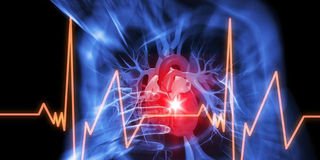The heart is not always in the right place

The heart is about the size of a fist and is located just behind and slightly left of the breastbone. PHOTO | FOTOSEARCH.
There is absolutely no way to adequately describe the experience of sitting the very final examinations in medical school. It is terrifying, extremely stressful, humbling yet remains a learning moment.
All doctors who walked through this baptism by fire will never forget this experience. Many more examinations will come in the course of the profession as we move from one level to another. Still, the initial test to earn the title ‘Doctor’ is one that remains engraved in our memories forever.
The written examinations are never designed to test how much you know but how fast you can recall and put it down in writing. The multiple-choice questions are so confusing they make us question what we have been doing in medical school for the past six years! Then come the clinical examinations.
TESTS
This is the practical examination where we are given a prescribed duration to interact with a real-life patient and then face the examiners, seasoned practicing doctors who are gauging your eligibility to be trusted with life. The clinical examinations generate hilarious reactions that would make for an award-winning medical comedy script.
Many have gone mute, suddenly unable to remember standard scientific terms used to describe the patient’s condition; others have confidently blurted out the wrong diagnosis. However, things get tricky when the patient’s body is all out of sync, and their organs are not where they are supposed to be.
A colleague once left us in stitches, describing his experience during his examination. In training, we are all taught to stand on the right side of the patient’s bed during an examination. Unfortunately, this grossly disadvantages the left-handed students who must learn to use the right hand to examine the patient.
We are all required to reach out to the far end of the patient’s lower chest with our stethoscopes to listen to the heartbeat.The heart is about the size of a fist and is located just behind and slightly left of the breastbone. So you can imagine the dismay of our colleague when he put his stethoscope delicately on the chest of his five-year-old patient, Hakeem*, and reported that he could not hear the heartbeat!
NO HEARTBEAT!
The examiners burst into laughter, and he froze! Hakeem lay there, all calm wondering what was so funny. His mom, who was all prepped up for the examination, looked away to hide her smile.
One of the examiners asked him how Hakeem could be alive with no heartbeat. He opened his mouth to respond, but no words came out. The examiners were having a field day while he was counting an extra three months in medical school preparing for a re-sit. His heart sank.
Amid the humour, they guided him to examine the rest of Hakeem’s chest, and suddenly, while listening over the right side, the familiar double-tap of the heart sounds was picked up, loud and clear. The poor gentleman got even more confused, and his mind ultimately failed to register what was wrong with this picture.
It took the examiners to show him a chest x-ray of the same patient for him to finally have his ‘ah huh” moment and pinpoint the diagnosis. Suffice it to say, this being an extraordinary patient, he did pass his exam but will never forget the moment. His little patient had a sporadic condition called dextrocardia.
This is a congenital abnormality that arises out of abnormal orientation of the heart during development. Eventually, at the end of the development process, the position of the heart in the chest cavity is a mirror image of the common area! The heart lies in the right side of the chest, pointing to the right instead of the left like all other normal hearts.
HEART DEFECTS
There are three types of this condition. The first is dextrocardia with situs inversus. Situs inversus refers to the mirror-image reversal of the organs in the chest and abdominal cavity. It is characterised by the abnormal positioning of the heart and other internal organs. Ninety-seven per cent of patients generally have no complaints and will live a healthy life.
It is often detected in the course of regular examinations and tests. The second type is dextrocardia with situs solitus, where the heart alone is wrongly rotated, but other organs are typically placed.
In this instance, the heart tends to have multiple abnormalities, and 80 per cent of babies born with this type of defect never live to see their first birthday. The third type is situs ambiguous, where all the organs in the chest and abdomen are disorganised with no apparent pattern established.
Various abnormalities arise depending on the variability, with outcomes dependent on the severity of the defects. Another rare occurrence is situs inversus with levocardia. In this case, the organs are all rotated to the opposite side, but the heart remains in its normal position.
Despite the heart being correctly sited, it will have multiple abnormalities that determine the severity of the patient’s conditions. Hakeem’s dextrocardia with situs inversus was incidentally diagnosed when he was two and had been hospitalised for pneumonia.
His mother was extensively educated about Hakeem’s condition to ensure it did not lead to mistakes in his care in the future. Imagine looking for his appendix on the right side of the abdomen while it is on the left side! Hakeem remained a favourite exam patient who dutifully contributed to the training of doctors by finding his way to our wards during our training, as a rare condition patient. He is special!



